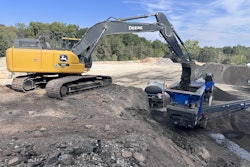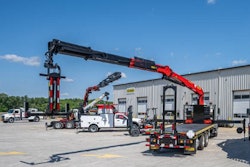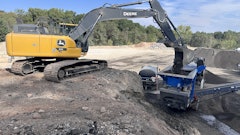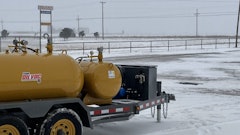
The most successful paving contractors aren't just skilled at laying asphalt - they've mastered the art of operational efficiency. While many companies rely on established manual workflows, forward-thinking firms are leveraging construction software to create competitive advantages that translate directly to their bottom line.
The technology exists today to create connected workflows that span every aspect of paving operations - estimating, bidding, scheduling, field execution, documentation, billing, and future project planning. Here are five ways technology is making a difference for asphalt contractors who refuse to settle for business as usual.
#1 Make Bid-to-Field Connections
For many contractors, the bridge between estimating and field operations is a spreadsheet-driven process that creates delays and disconnects. When a project is won, the detailed assumptions, quantities, and resource allocations used to calculate the winning bid often live in static files that don't communicate with field tracking systems.
Integrated construction software eliminates these bottlenecks by creating direct data flow from estimating to field operations. For instance, Minneapolis-based Bituminous Roadways implemented B2W's connected platform, which allows bid data to automatically move to field tracking and resource scheduling applications.
"Once a project is won, bid data flows directly to B2W Track and B2W Schedule," explains Nate Larson, construction technologist with Bituminous Roadways. "This allows managers to establish daily field logs and assign resources according to how the job was envisioned in the bid."
The greatest value is that field crews work from the same assumptions used in bidding, eliminating manual re-entry and ensuring projects proceed according to plan.
#2 Precision with Purpose
Conventional grading methods rely heavily on operator skill and experience, often resulting in a time-consuming trial-and-error approach. The emergence of 3D machine control technology has reshaped traditional practices.
Jacob Buck, co-owner of Buck Brothers Asphalt Paving & Concrete in Toledo, Ohio, describes their former process: "We didn't have graders or dozers at the time, so we would run stone through an old asphalt paver to achieve grade. While it worked, it was difficult to achieve a perfect grade. It became a 'guess and check' process that required considerable skill."
A few years ago, Buck Brothers implemented 3D machine control guided by Trimble's SPS930 Universal Total Station with 3D modeling workflows, which immediately delivered millimeter-level precision guidance and eliminated guesswork.
"In the two short months before the season closed in 2023, Buck Brothers was able to fine grade over 300,000 square feet of stone base before paving," Buck reports. "We literally cut our prep time in half and delivered effective drainage in every situation. Now I know that everything we pave is at the right thickness and is going to drain correctly."
#3 Streamline Material Coordination
For many pavers, material coordination represents one of the most time-sensitive challenges. Hot mix asphalt has a narrow temperature window for proper placement, making coordination between plant production, trucking, and paving crews absolutely critical. Conventional methods rely on phone calls and radio communication to manage deliveries, often resulting in costly delays when trucks arrive too early or too late.
Digital dispatching platforms transform material coordination through real-time visibility and automated scheduling. Bituminous Roadways dramatically increased its capacity using integrated software that connects scheduling data directly to truck dispatching applications.
"Our ability to dispatch over 200 trucks in a day, compared to 80 trucks in previous years, speaks to efficiencies we've gained," according to Kim Scales, IS technology manager at Bituminous Roadways. This 150% increase in dispatching capacity demonstrates how real-time solutions enable firms to coordinate material deliveries with precision, ensuring hot mix arrives when paving crews need it rather than when convenient for plants or trucking companies.
Advanced dispatching platforms also incorporate geofencing technology, allowing dispatchers to verify equipment location before scheduling moves and eliminating costly trips to empty jobsites.
#4 Automate Field Documentation
Conventional quality control in asphalt paving relies on post-construction testing and final inspection - a reactive approach that discovers problems after it's expensive to fix them. Crews work with limited real-time visibility into project performance, making adjustments based on experience rather than quantifiable data. Manual documentation is time-consuming and often provides feedback too late to influence ongoing operations.
It’s a common practice that leaves firms hoping everything went right rather than knowing it did. Real-time data collection throughout the project lifecycle transforms quality control from reactive to proactive. Effective field documentation also improves communication between field and office teams.
At Palmer Paving Corp., a Massachusetts-based asphalt producer and paving contractor, field crews provide detailed insights through digital logs. "They leave a lot of notes for us, because they're basically our eyes and ears out there," explains Palmer Paving's contract administrator Mary Lessard. "What they enter in those field logs give me a picture." That same data is used for future bidding on similar jobs.
Automated field documentation and integrated platforms can also help streamline equipment maintenance. For example, Bituminous Roadways replaced what Scales called "antiquated software" with B2W Maintain, which connects maintenance scheduling with job scheduling to minimize equipment downtime. "We now proactively schedule maintenance and track detailed equipment repair costs," she says. "Mechanic hours also transfer automatically to Viewpoint Spectrum for payroll." This integration ensures maintenance work happens during planned downtime rather than disrupting active projects.
#5 Stay Pain-Point Focused
It’s important to remember that technology adoption doesn't require an all-or-nothing approach. The most successful firms identify their biggest operational headache and solve that first, then build from there.
Bituminous Roadways took this incremental path, transitioning from spreadsheets to B2W Estimate as their bid volume increased, then gradually adding field tracking, scheduling, and maintenance modules to create their connected workflow over time.
Similarly, Buck Brothers’ Jacob Buck faced a choice: "It was either learn machine control or learn to manually operate a grader/dozer. It made more sense to go the machine control route." He started with Trimble's Universal Total Station for one specific challenge - fine grading - then expanded his 3D capabilities as confidence and expertise grew.
These companies succeeded because they avoided the temptation to digitize everything simultaneously. Instead, they identified their most time-consuming manual processes and tackled those first. Whether your biggest challenge is equipment maintenance scheduling, crew coordination, or material dispatching, the key is picking one area and doing it well before expanding.
Subscription-based technology models can also ease adoption by reducing upfront capital investments while ensuring firms always have access to the latest features and updates.
The Competitive Value
The firms profiled in this story share a common thread: they didn't view technology as a replacement for their expertise, but as a multiplier of their capabilities. By connecting previously isolated platforms - estimating, scheduling, field operations, and project documentation - they are creating workflows that eliminate waste, reduce errors, and maximize the value of every crew hour.
The industry landscape is shifting. Companies embracing these integrated approaches are winning more bids with accurate pricing, completing projects faster with better quality, and scaling operations without proportionally increasing overhead. As these advantages become standard practice, contractors who implement them will find their workflows become as smooth and efficient as the roads they build.



















